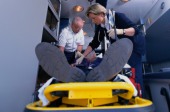
THURSDAY, June 2 (HealthDay News) — Use of a life-saving clot-busting drug to treat ischemic strokes nearly doubled from 2005 through 2009, but the rates still remain too low, a new study finds.
Acute ischemic stroke occurs when a blood clot cuts off blood supply to the brain. Tissue plasminogen activator (tPA) is the only thrombolytic (clot-dissolving) drug approved to treat this type of stroke in the United States, and it can stave off death and lasting disability, but only if it is administered within 3 to 4.5 hours of stroke onset.
“Overall, tPA treatment rates are improving, but the proportion of ischemic stroke patients receiving the therapy remains very small,” said study author Dr. Opeolu Adeoye, an assistant professor of emergency medicine and neurosurgery at the University of Cincinnati in Ohio. “The delayed hospital arrival in the majority of stroke patients is probably the most important factor contributing to low treatment rates.”
The findings are published June 2 in the journal Stroke.
In the study, researchers used Medicare records and pharmacy billing codes to see if tPA use had increased in response to measures aimed at improving access to this treatment.
In 2005, 1.1 percent to 1.4 percent of acute ischemic stroke patients received a thrombolytic drug, and 3.4 percent to 3.7 percent received one in 2009.
But after adjusting the numbers to account for billing or coding errors, the researchers found that as many as 5.2 percent — or about 36,000 of the 700,000 Americans who had an ischemic stroke in 2009 — received tPA. The study did not track individuals after hospital discharge, so it does not provide any data on how they fared following treatment. The presumption is that the tPA did preserve function and prevent lasting stroke-related disability.
“Increasing public awareness of stroke signs and symptoms, and earlier hospital arrival by stroke patients remain important goals for improving treatment rates further,” Adeoye said. “The treatment can only be given in the first few hours after a stroke, but many patients delay seeking care, hoping the symptoms will go away,” he noted.
“If someone is suspected of having a stroke, 911 should be called and the person immediately transported to the nearest stroke-ready emergency department,” Adeoye explained.
Dr. Irene Katzan, director of the Primary Stroke Center at the Cleveland Clinic in Ohio, said that the new study is great news and confirms what she has seen in her practice. It is gratifying to see that slowly things are moving along, she added.
In stroke care, the mantra is the sooner the better when it comes to tPA use, but a lot has to happen in a very short period of time. Also, some strokes may occur during sleep so the time of onset of symptoms may be unknown, experts have noted.
Stroke symptoms may include sudden numbness or weakness of the face, arm or leg (particularly on one side of the body), trouble speaking or understanding speech, sudden vision problems, sudden trouble walking, dizziness or balance issues, and a severe headache with no other cause.
If someone has a stroke and 911 is called, the ambulance must get them to a stroke center as soon as possible, Katzan said, and there must be processes in place in the hospital to evaluate them rapidly. She said tPA can’t be used in bleeding strokes or in individuals taking blood-thinning drugs, with high blood pressure or high blood sugar (glucose) levels. Also, there are state mandates that direct emergency medical services to take patients with acute strokes to the closest stroke center.
“Then the patient would fly through the emergency room, get evaluated with a CAT scan and have blood work within minutes, and if they are a candidate, the intravenous tPA is started,” Katzan said.
For this to occur, “everything has to be working correctly,” she explained.
When the drug is administered in the right patient, it can work wonders. “Ideally, the person’s stroke symptoms are minimal to none three months after the stroke,” Katzan said.
Dr. Roger Bonomo, director of stroke care at Lenox Hill Hospital in New York City, said that although there is room for improvement, “it’s good news that tPA is being used more.”
But obstacles remain. “We need to get people to come to the hospital sooner rather than waiting a while to see if the stroke symptoms get better on their own,” he said.
More information
Find out about stroke’s warning signs at the American Heart Association.

